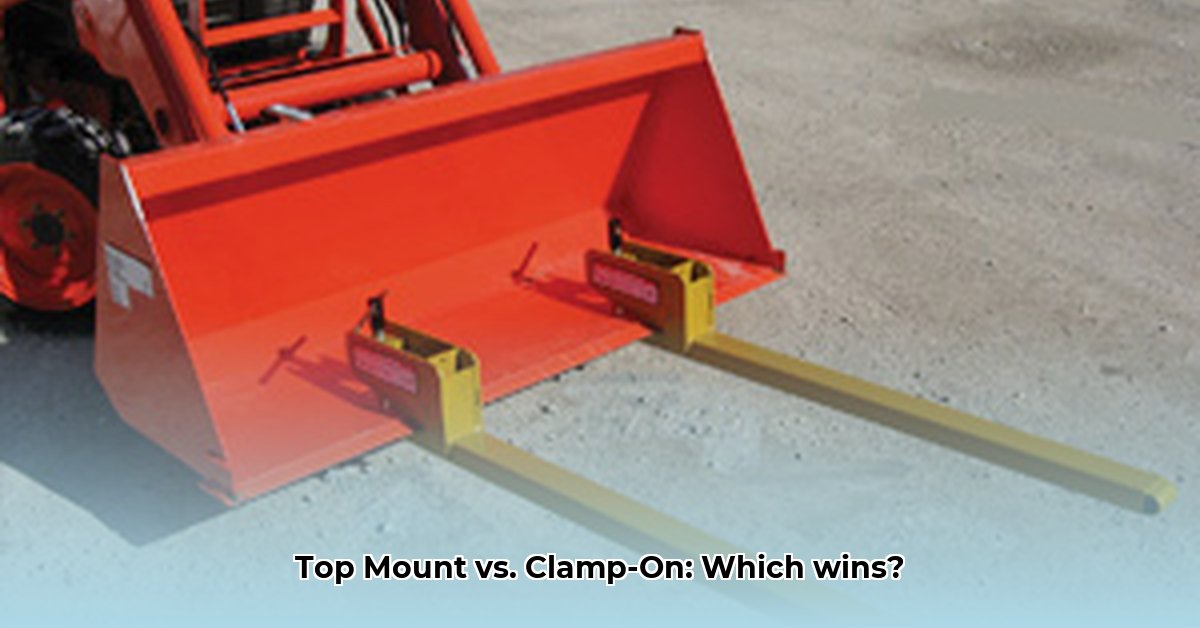
Choosing the right bucket forks for your tractor is crucial for efficient and safe operation. This comparative review analyzes top-mount and clamp-on forks, highlighting key differences to help you make an informed decision. We'll examine popular brands like All-Pro and VEVOR to illustrate the variations in design and performance. For more information on quick-attach forks, see this helpful guide.
Top-Mount Bucket Forks: Strength and Simplicity
Top-mount bucket forks are welded directly onto your tractor's loader arms, creating a rigid, integrated system. This design, often favored by brands like All-Pro, prioritizes strength and longevity.
Advantages of Top-Mount Forks
- Superior Strength: The welded construction allows for higher lift capacities and better weight distribution, minimizing the risk of bending or breaking. This is especially important when handling heavy loads consistently.
- Simplified Installation: Installation is usually straightforward, reducing downtime and requiring less specialized expertise.
- Reduced Maintenance: Fewer components mean less potential for breakdowns and maintenance issues, translating into cost savings over the lifespan of the forks.
- Precise Fit: Many manufacturers offer tailored options to perfectly match your tractor's loader arms, ensuring a secure and compatible fit.
Disadvantages of Top-Mount Forks
- Limited Adaptability: Once installed, they are typically designed for specific bucket sizes. Switching buckets may require purchasing new forks.
- Lower Versatility: They may not fit every loader arm configuration without modifications.
Clamp-On Bucket Forks: Versatility and Adaptability
Clamp-on forks, frequently offered by brands like VEVOR, attach to your existing loader bucket using a clamping mechanism. This design emphasizes versatility and ease of swapping between buckets.
Advantages of Clamp-On Forks
- Wide Compatibility: These forks typically work with a wider range of bucket sizes and types, providing greater flexibility in your operation.
- Easy Bucket Swapping: Changing buckets is a quick and simple process compared to top-mount forks, increasing operational efficiency.
- Greater Tractor Compatibility: They may be adaptable to different tractors, representing a more versatile long-term investment.
- Potentially Lower Initial Cost: Clamp-on forks generally have a lower upfront purchase price.
Disadvantages of Clamp-On Forks
- Lower Strength: The clamping mechanism is often the weakest point, meaning these forks may not handle the same heavy loads as welded alternatives. Overloading can lead to damage or failure.
- More Complex Installation: Proper installation requires careful adjustment of the clamps to ensure a secure and stable connection. Improper installation can compromise safety and performance.
- Increased Maintenance: Clamps may require regular tightening or replacement, adding to maintenance costs and workload. Regular inspection is crucial.
- Lower Weight Limits: Clamp-on forks typically have lower weight limits, limiting their suitability for heavier materials.
Choosing the Right Bucket Forks: A Comparative Analysis
The following table summarizes the key differences between top-mount and clamp-on bucket forks:
| Feature | Top-Mount Forks | Clamp-On Forks | Considerations |
|---|---|---|---|
| Installation | Relatively Easy | More Complex | Mechanical aptitude & available time |
| Strength | High | Moderate | Weight of typical loads and frequency of use |
| Versatility | Low | High | Need for different bucket sizes and types |
| Cost | Higher initial cost | Lower initial cost | Consider total cost of ownership (including repairs) |
| Maintenance | Low | Higher; regular clamp inspections needed | Long-term maintenance costs |
| Safety | Higher inherent safety due to sturdiness | Higher risk of bucket or clamp failure | Prioritize safety; never overload the forks |
Key Questions Before You Buy
Before making a purchase, consider these essential questions:
- What types of materials will you be handling? Heavy materials require stronger forks.
- What's the weight of your typical loads? This directly impacts the required lift capacity.
- How frequently will you use the bucket forks? Frequent use necessitates durable, robust options.
- What's your budget? Account for both the initial cost and potential repair expenses.
- What is your level of mechanical expertise? Clamp-on installation demands greater mechanical skill.
Conclusion: Matching Forks to Your Needs
The optimal choice depends on your specific requirements. Farmers needing high strength and reliability for heavy, frequent use should opt for top-mount forks. Those with lighter, less frequent needs and a tighter budget may find clamp-on forks sufficient. Remember to always prioritize safety and never exceed the stated weight capacity. Regular inspection and maintenance are crucial regardless of the type chosen to ensure longevity and efficient operation.